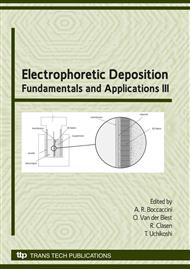p.221
p.227
p.233
p.237
p.243
p.249
p.255
p.261
p.267
Galvanostatic Electrophoretic Deposition of Yttriumsilicate on C/C-Si-SiC Composites
Abstract:
The use of carbon fibre reinforced carbon composites in oxidizing atmospheres is limited to temperatures below 400 °C. To benefit from their excellent mechanical strength that is still preserved at high temperatures, suitable oxidation protection coating systems have to be developed. Composites which are capillary infiltrated with Si and coated with SiC via chemical vapour deposition show significantly enhanced oxidation resistance. For the increase of service temperature above 1300 °C, high temperature stable materials with low oxygen diffusivities such as yttrium silicates have to complement the SiC coating. The electrophoretic deposition performed under constant current conditions leads to relatively high green densities and therefore good sinterability of the applied coatings. In this work we present the preparation of suspensions, their characterization regarding particle size and electrophoretic mobility for yttrium silicate powder prepared by the solid state method. Depending on particle charge and conductivity of the investigated suspensions iodine is employed to increase particle charge. The use of current densities between 0.5-5mA/cm² leads to smooth and homogeneous layers. Layers sintered as low as 1400 °C for 2h already show promising protection of the C/C-Si-SiC substrate during thermogravimetric analysis.
Info:
Periodical:
Pages:
243-248
Citation:
Online since:
June 2009
Price:
Сopyright:
© 2009 Trans Tech Publications Ltd. All Rights Reserved
Share:
Citation:


